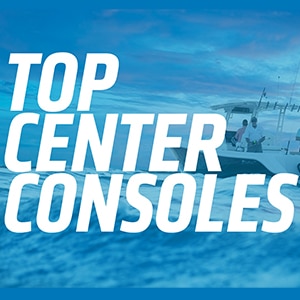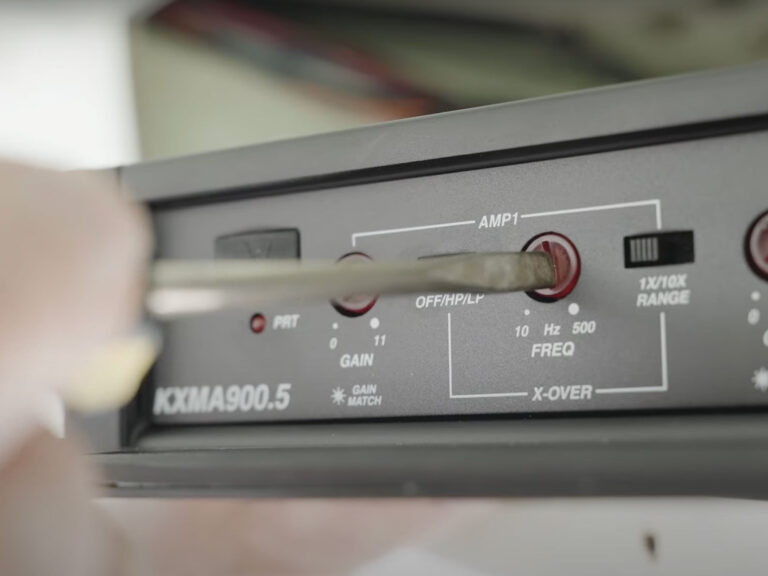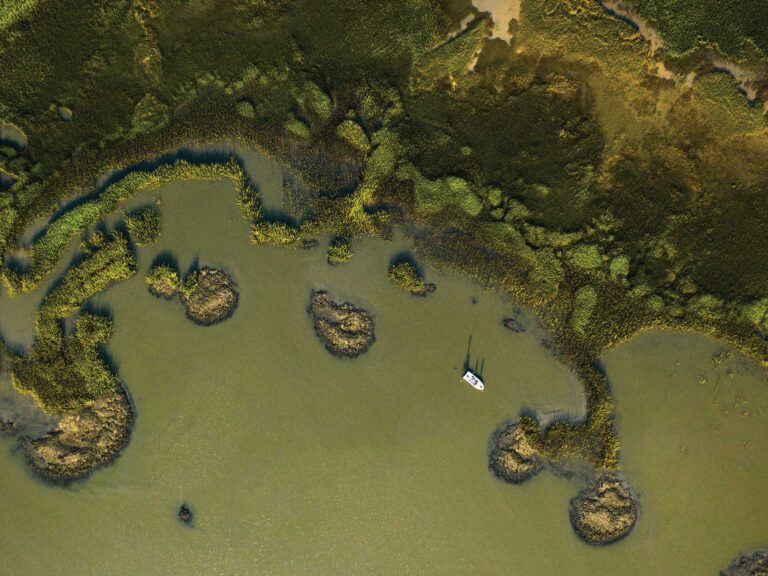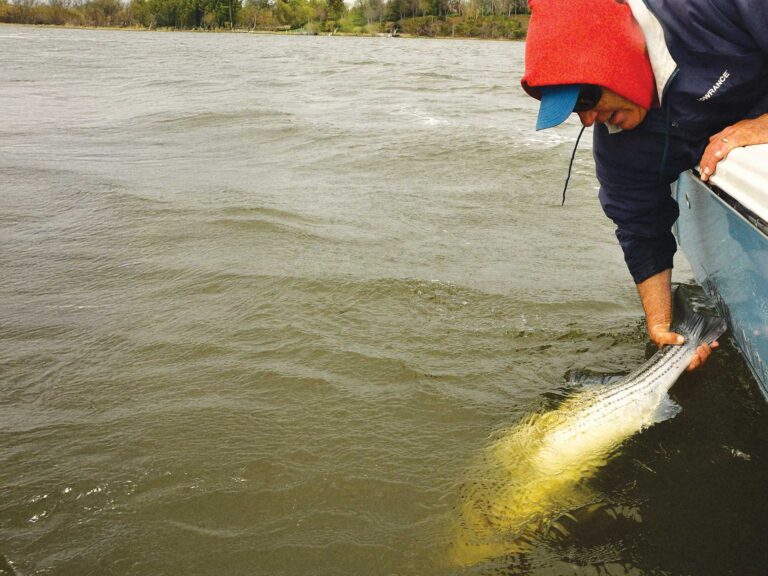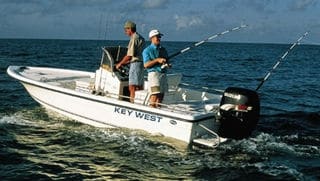
| Boats under 20 feet allow the angler to maneuver precisely while trolling. |
Ask the average inshore angler what his least favorite method of fishing is and chances are he’ll say trolling. Even fishermen who catch lots of fish via trolling prefer to cast. But you can’t catch fish until you locate them, and one of the best ways of doing this is – you guessed it – by trolling! That’s true for fish big and small, in bays, sounds, inlets, tidal rivers and even small backwater creeks.
Trolling is simply the best way to cover a lot of water in a short amount of time, which is what must be done when trying to find fish. It’s especially productive when investigating a sound or inlet for the first time. Anglers who work the same inshore waters time after time get to know exactly where the fish hang out on any given day, which makes casting a better choice. However, in unfamiliar areas where all the tidal creeks and points look the same, or when your usual casting hot spots draw a blank, trolling is the best and fastest way to find the action.
Trolling also allows you to work lures quickly through the water, which is often needed to trigger strikes from inshore species that prefer a fast meal. If you can’t get fish to strike cast lures, trolling can sometimes be the ticket to success, because you can troll lures faster over long distances than you can retrieve them.
The Buck Trolls Here
Savvy inshore anglers who spend time trolling soon learn that there are a wide variety of ways to go about it, and many subtle techniques that score. Inshore trolling is very similar to the kind of small-boat trolling for largemouth bass and other fresh water species I learned as a youngster. And I learned from the best – structure-fishing guru Buck Perry of Hickory, North Carolina.
Buck is known as the father of structure fishing, and trolling is his forte. He trolled and sold a line of lures called Spoonplugs that dove to specific depths, no matter what the trolling speed. Different lures ran at different depths. For example, one model swam at five feet, another at ten feet, another at 15 feet, and still another at 25 feet. The lures were and still are deadly on fresh water fish, but they also work in the salt.
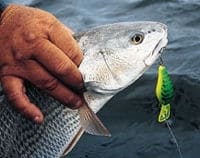
Trolling big-lipped, deep-diving crankbaits designed for fresh water bass has helped the author score red drum around Florida sandbars.|
Spoonplugs have long been popular among a select group of Florida snook fishermen who troll along deep edges. Generations of South Florida anglers have boated some huge fish over the years by trolling Spoonplugs along mangrove shorelines, deep channels, inlets, passes, drop-offs and jetty rocks. Over the years, trolling Spoonplugs and other deep-diving plugs around structure has led me to countless numbers of red drum, seatrout, striped bass, bluefish, tarpon, snook, cobia, flounder, jacks, ladyfish, snapper, grouper and many other species.
Redfish Revelation
I clearly remember the first time I tried trolling inshore. I’d just moved to north Florida, and a couple of pals had invited me to catch redfish around a series sandbars using Big O bass lures. The Big O was the first “fat” crankbait, and was all the rage among fresh water bass fishermen. However, catching redfish on it was unheard of.
We caught a few reds by casting and cranking the plugs around the sandbars, which dropped sharply into a 40-foot channel, but we never stayed on the fish for long. I suggested trolling for them, and we soon located reds every time the casting action cooled. When the fish finally moved deeper than the Big Os would dive, we switched to Spoonplugs and other deep-running crankbaits. By trolling these lures, we destroyed the reds, catching close to 50 fish. In addition, we caught flounder, ladyfish, big jacks, bluefish and even jumped a tarpon.
Some of the best inshore trolling spots are located near deep-water drop-offs. Keep in mind that “deep” is a relative term. If the bay or estuary has a pretty standard depth of, say, ten feet, then a 12- to 15-foot hole is noteworthy. Often the very best holes are located in places where the tidal current is strong. The outer edges of river or creek bends usually have holes, too. The holes that attract the most game fish are often located near sandbars, oyster bars and grass beds. Shell bars and grass are best, since they hold the most bait.
An ideal inshore trolling spot would be a large hole about the size of a house or two, with several oyster bars around its edges and a few nearby grass beds. If the tide is sucking bait into the area, so much the better. Predators cruise the drop-off, looking for baitfish, crabs, shrimp and other goodies being flushed out of their hiding places in the shell or grass. By trolling along the drop-off, you’ll quickly find the key spots where tide, bait and game fish all converge.
Sounder Advice
While such productive trolling spots can often be identified at low tide or by examining charts, a depthsounder is invaluable. Many successful inshore trollers don’t use sounders, but I never feel as though I’m fishing effectively without one. The sounder should have a narrow depth scale, say from zero to 30 feet. This allows for greater definition of inshore bottom terrain than a sounder with a scale of zero to 100 feet. With the narrow scale, even slight drop-offs can be easily detected.
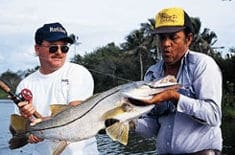
Trolled plugs are deadly on snook, especially when fished through deep holes and along channel edges. Try a variety of plugs at different depths until one draws a strike.|
While it’s important to troll lures and baits through deep holes, fish often station themselves around the edges of holes. Therefore, it’s wise to troll the entire deep-water area. Using a floating marker to pinpoint the hole will help you keep your trolling passes precise and show you where you’ve already fished.
As in all marine fishing, tide makes a big difference in trolling. Different inshore spots produce best at different times, but, generally speaking, low, moving water is best for working holes. During high tides, the neighboring bars and flats often harbor the majority of fish, which tend to spread out to hunt for food.
Most species can be caught by trolling both with the tide and against it. However, trolling upcurrent has worked better for me, probably because it gives me better control over the boat and the lure. Also, most fish face into the current. Game fish are not accustomed to seeing food swim directly toward them with the tide, because prey usually tries to swim away from predators, not at them.
The Speed Factor
Trolling speed can be vital to success, which is why it’s important to note your boat speed in relation to the current. If you hook up by trolling into the tide, then turn around and troll with the tide, your speed will increase tremendously. When you hook a fish, note your engine rpm and the angle of your boat in relation to the current, then try to duplicate these factors on subsequent passes though the area.
While inshore trolling can be done with big boats and motors, a smaller, more nimble boat of under 20 feet will allow you to make precise maneuvers. but I prefer boats that are small enough to be powered by tiller-steered motors. Modern tiller-steered outboards (under about 50 hp) are ideal for inshore trolling. They have throttles on the steering grips so the angler can control his speed with one hand while holding a fishing rod in the other.
Trolling a deep rip for bluefish, Spanish mackerel or stripers is easy in a big boat with a 200-hp motor. The fish are usually aggressive in this situation, and keeping the boat and lures in the right position is rarely a problem. However, if the fish are holding in a precise spot along a sunken ledge, where wind and tide are pushing in opposite directions, a low-profile skiff that can make tight trolling turns is a much better means of putting a lure on the dinner plate.
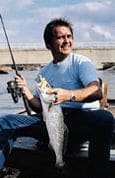
When seatrout are holding deep, trolling a leadhead jig on light tackle can spell success. |
Almost any tackle can be used for inshore trolling. When light trolling for small striped bass, bluefish, seatrout, flounder and jacks, any medium-stiff baitcasting or spinning rod will do, provided you don’t need to work great depths or troll large lures.
When trolling for larger fish and/or working deeper water, more specialized outfits are needed. Most rods should be stiff and in the six- to 7 1/2-foot range. Spinning models can be used, but many experienced trollers prefer baitcasting rods, especially long popping or “flipping” models. A revolving-spool reel makes it easier to drop lures back and retrieve them while trolling, and line twist is less likely to be a problem with baitcasting tackle as with spinning gear.
Braid Aid
For most trolling situations, standard monofilament line is suitable. Sometimes, though, such as when long lines are used or when fishing for tough-mouthed fish, special low-stretch mono or braided line is best. For deep fishing, some anglers use planers, downriggers, wire or leadcore line, but some deep-running plugs can be trolled down to 30 feet on their own. If you need to get deeper, slow-trolling with jigs or heavy metal spoons (e.g., Hopkins or Kastmasters) works well, especially for fish such as stripers, bluefish, redfish, flounder and seatrout.
Many types of terminal-rig arrangements can be used for deep inshore trolling. One of the most common, and a good one, is a three-way-swivel setup that features a heavy, oblong sinker tied to one eye of the swivel. A swimming plug is attached to a second eye of the swivel via a long leader. The line connecting the sinker to the swivel is usually weaker than the fishing line or leader, so that if the sinker snags on the bottom it will break off, thereby saving the rest of the rig. This rig can be used to troll plugs, spoons, spinners and natural baits, and a good three-way swivel will prevent line twist.
Other unique inshore trolling rigs have been devised over the years. One of the most effective is the “bottom-bouncer” rig made by companies like Lindy Tackle (for information, call (218) 829-1714). There are numerous designs and shapes, but basically a bottom-bouncer has a weight attached to one arm of a vee-shaped wire. The wire rides on its side, weight down, while a lure or bait attached to a leader trails off the top part of the vee. The fishing line is attached near the point of the vee. Trolling bottom-bouncers is deadly on redfish, flounder, seatrout and snook, especially when natural baits are employed.
How Far Back?
Some novice trollers have a difficult time determining how far behind the boat to run their lures. The general rule is to run a long line in shallow water (under eight feet deep). Of course, this distance may be dictated by the area being fished, since some winding tidal rivers require shorter lines. However, in broad, open estuaries, long-line trolling is usually no problem.
In shallow water, I run my lures back a minimum of 40 yards, sometimes farther. With live baits, especially in deep or cold water, I run a much shorter trolling line, particularly when slow speeds are employed. Sometimes a jig or spoon can be trolled deep and slow almost directly under the boat, which is ideal for precise trolling presentations, such as when working small, underwater ledges and oyster bars while your eyes are glued to the depthsounder.
The beauty of trolling is that it almost can’t be done incorrectly. Anglers can refine their inshore trolling tactics and techniques to a remarkable degree, but plenty of fish also are caught by simply tossing a diving plug, jig or spoon behind the boat and pulling it through an open bay or river. It’s the kind of fishing almost anyone can do and still put fish in the boat – and that’s about the best endorsement any fishing technique can get.





